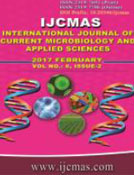


 National Academy of Agricultural Sciences (NAAS)
National Academy of Agricultural Sciences (NAAS)

|
PRINT ISSN : 2319-7692
Online ISSN : 2319-7706 Issues : 12 per year Publisher : Excellent Publishers Email : editorijcmas@gmail.com / submit@ijcmas.com Editor-in-chief: Dr.M.Prakash Index Copernicus ICV 2018: 95.39 NAAS RATING 2020: 5.38 |
Pseudomonas aeruginosa is an opportunistic pathogenic bacterium responsible for both acute and chronic infection causing serious infections in patients who are mechanically ventilated individuals, who are immunocompromised, and patients with malignancies or HIV infection. The present study was undertaken with the aim to find prevalence of Metallo-β-Lactamases producing Pseudomonas aeruginosa among clinical isolates by different phenotypic confirmatory methods. The study was carried out in the Department of Microbiology, Rama Medical College, Kanpur for the period between January 2016 to August 2016. A Total of 86 Pseudomonas aeruginosa isolated from different clinical samples including urine, sputum, ear swab, wound swab specimens, pus were identified by standard microbiological techniques & the isolates were further tested for MBL by screening test, and all screening positive were confirmed by Imipenem – EDTA combined disc test, Modified Hodge test and MBL E test (Imipenem). Out of 86 Pseudomonas aeruginosa isolated 29(33.7%) were screening test-positives by imipenem, meropenam and third generation cephalosporins. Of which 14(48.2%) were MBL positive by Imipenem – EDTA combined disc test, 15(51.7%) by Modified Hodge test and 19(65.5%) by MBL E test. MBL E-Test followed by modified Hodge test was found to be the best phenotypic method for detection of MBL. The appearance of the Metallo-β-Lactamases and their spread among bacterial pathogens is a matter of concern with regard to the future of antimicrobial therapy. So, MBL detection method is recommended into the daily routine clinical laboratory.
 |
 |
 |
 |
 |